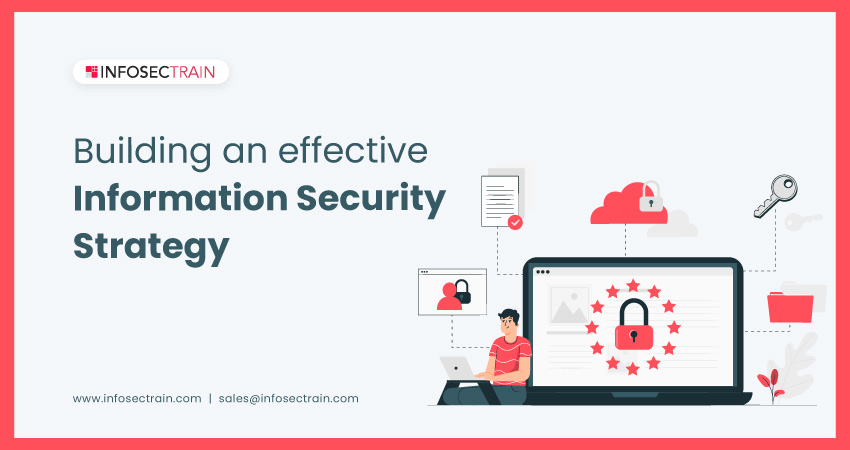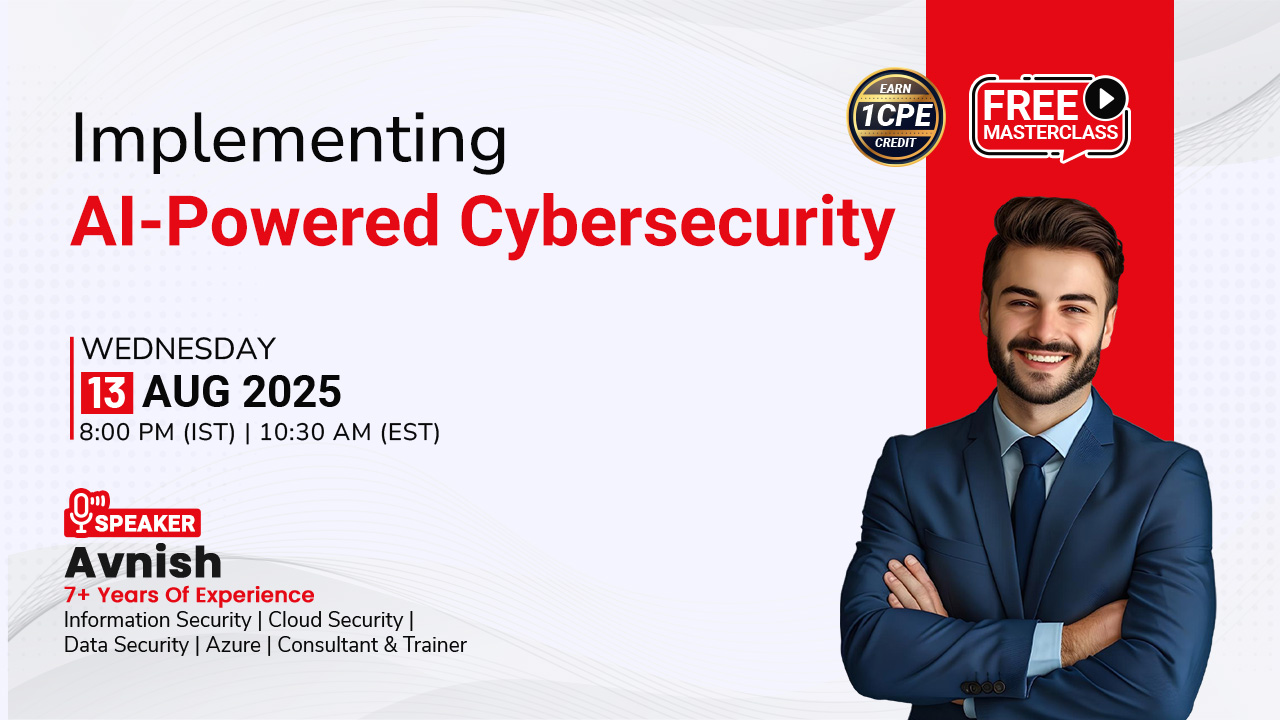Building an effective Information Security strategy
As the company progresses in the field of networking every day, resources and devices develop tremendously, resulting in an ever-increasing risk of exposure. Nowadays, every company is putting all of its operational data on the cloud infrastructure, which is raising cyber risks and placing the firm’s assets, intellectual property, and employees at risk. To identify the cybersecurity risk, we must design an appropriate cybersecurity strategy for our organization to safeguard essential credentials.

In this post, we will discuss what a cybersecurity strategy is and how to develop an effective cybersecurity strategy.
What is a cybersecurity strategy?
A cybersecurity or information security strategy is a solution for organizations handling cyber risks and securing digital assets from hackers and cybercriminals. The goal of establishing and implementing a plan is to figure out how to keep your data and information safe. By devising solutions, you can protect your company’s reputation while also reducing the risk of harm to the company and its employees.
Cybersecurity strategies are often designed with a three to five-year plan, but they should be updated and evaluated as often as possible.
Developing an effective cybersecurity strategy
1.Risk inventory and landscape
The first and foremost step in developing an Information Security strategy is to conduct a risk-aware and comprehensive inventory of your company’s context, including all digital assets, employees, and vendors. Then you need to know about the threat environment and which types of attacks are a threat to your company. It makes assessing internal and external malicious threats and flaws simple. Risk thresholds depend on the financial strength of your enterprise, the industry you are in, the goals you are pursuing, and more. You should evaluate your organization’s risk and stakeholder expectations, comprehend your present security condition and prioritize security projects and plans.
2. Collaboration and communication
If you need to design security strategies, you will need to communicate with each employee, manager, vendor, and the rest of the business so that everyone can offer opinions and understand the plans. You should ensure you have the necessary resources to design a security strategy and policy. Collaborate with other members of the organization to discover common occurrences and determine what needs to be done. Assuring they have the knowledge and resources to isolate problems, establish the appropriate level of investigation, and keep operations running smoothly.
3. Cybersecurity Framework
To develop a plan, you must first choose a framework, a blueprint of policies, goals, and procedures that define all of an organization’s cybersecurity activities. You can efficiently track the progress of your business goals by selecting the correct framework for your organization.
Some of the most common cybersecurity frameworks are:
NIST CSF: The NIST Cybersecurity Framework contains standards for detecting, guarding, responding to, and detecting cyberattacks, as well as managing cybersecurity risk.
ISO/IEC 27001: ISO/IEC 27001 is an International Organization Standard. This framework assists businesses in operating, monitoring, maintaining, and improving an information system.
ISF: The Information Security Framework is a practical approach that assists organizations and supply chains in identifying and managing risks. It aids in developing a framework for cyber security standards, policies, and processes within a company.
4. Security Policies
Security policies are a set of regulations developed by an organization to guarantee that authorized users follow the information security rules and standards. It is a company-wide rulebook that is required for a successful cybersecurity plan. If your company doesn’t have an Information Security policy for a particular area of concern, security is likely to be chaotic, fragmented, and ineffective.
Security policies are required:
- It boosts productivity.
- It promotes accountability and discipline.
- It has the power to make or break a commercial agreement.
- It aids in the security literacy education of individuals.
Consider the following while creating your cyber security policy:
- Password specifications
- Access permissions with zero trust and minimal access
- Identity and Access Management (IAM) and credential management
- Safeguarding confidential information
- An incident response plan for cyber security incidents
- Surveillance and detection of any odd activities
5. Tech Stack and automation
Security policies are not only valuable for any organization; they also need the usage of technology. The Tech stack is used by organizations to identify, respond, detect, and combat threats. For risk and compliance management, you will need a tech stack. Automating the threat detection process is the best thing you can do for your organization. You may also utilize the Cyber Defense Matrix to find any security flaws you may have.
6. Multiple lines of defense
Multiple lines of defense are required in a cybersecurity plan for security reasons since attacks on your code can come from both internal and external sources. If you have various defense tools and methods, you can quickly recognize dangers, but layering access control with monitoring and automated scanning is preferable.
7. Zero trust and access control
Zero trust is also the most significant aspect of the organization’s security plan. Organizations should review the user’s directory on a regular basis and manage user segmentation using the inventory that you produced previously. Zero trust is a security concept that requires users to verify before being provided access to apps and data and enforces rigorous access controls. Make sure the user list is continuously updated.
How can InfosecTrain help you?
Join InfosecTrain, if you are interested in learning more about the topic of Cybersecurity or information security. They have competent instructors who will provide excellent expertise and understanding of the material. They will offer you Cybersecurity training courses that are useful in security, such as:
TRAINING CALENDAR of Upcoming Batches For CEH v13
| Start Date | End Date | Start - End Time | Batch Type | Training Mode | Batch Status | |
|---|---|---|---|---|---|---|
| 26-Jul-2025 | 31-Aug-2025 | 19:00 - 23:00 IST | Weekend | Online | [ Open ] | |
| 16-Aug-2025 | 28-Sep-2025 | 19:00 - 23:00 IST | Weekend | Online | [ Open ] |
TRAINING CALENDAR of Upcoming Batches For CISSP
| Start Date | End Date | Start - End Time | Batch Type | Training Mode | Batch Status | |
|---|---|---|---|---|---|---|
| 17-Aug-2025 | 27-Sep-2025 | 19:00 - 23:00 IST | Weekend | Online | [ Open ] | |
| 23-Aug-2025 | 28-Sep-2025 | 09:00 - 13:00 IST | Weekend | Online | [ Open ] | |
| 06-Sep-2025 | 12-Oct-2025 | 09:00 - 13:00 IST | Weekend | Online | [ Close ] | |
| 08-Sep-2025 | 13-Oct-2025 | 08:00 - 10:00 IST | Weekday | Online | [ Open ] | |
| 29-Sep-2025 | 04-Oct-2025 | 09:00 - 17:00 IST | Weekend-Weekday | Classroom Bengaluru | [ Open ] | |
| 06-Oct-2025 | 27-Oct-2025 | 07:00 - 12:00 IST | Weekday | Online | [ Close ] |









 1800-843-7890 (India)
1800-843-7890 (India)